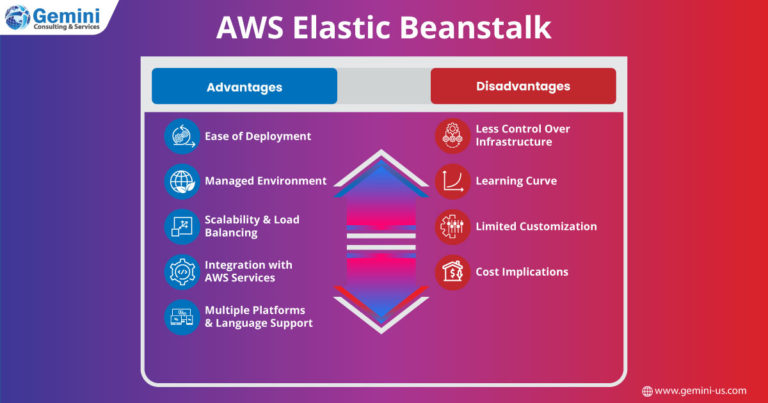The increased pace of digitalization has prompted enterprises to look for solutions that offer flexibility and scalability in deploying and managing their applications. This is where Amazon Web Services (AWS) Elastic Beanstalk comes into play. AWS Elastic Beanstalk is a fully managed service that can transform the way enterprises operate by simplifying the process of deploying and scaling web applications and services.
AWS Elastic Beanstalk offers a platform-as-a-service (PaaS) environment, allowing developers to focus on writing code rather than managing the underlying infrastructure. It enables developers to easily deploy applications written in various programming languages such as Java, .NET, Python, Ruby, and Node.js. The service handles the provisioning and management of EC2 resources making it effortless to get applications up and running.
AWS Elastic Beanstalk automatically adjusts the resource capacity based on application traffic and demand. Due to its seamless integration capability with other AWS services, developers can easily incorporate services like Amazon RDS for databases, Amazon S3 for storage, and Amazon CloudWatch for monitoring into their applications. This integration simplifies the development process and enables developers to leverage the full potential of the AWS ecosystem.
It also supports multiple application environments and optimizes costs by automatically scaling resources to match application demand.
AWS Elastic Beanstalk is a powerful service that enables enterprises to focus on their core competencies, accelerates development cycles, and provides a scalable and reliable platform for deploying web applications. Gemini Consulting & Services can help your enterprise to take advantage of the AWS Elastic Beanstalk to improve productivity. Contact us to know more about how this service can be integrated with other AWS services to deliver high-quality applications efficiently.
Amazon Web Services (AWS) follows the platform-as-a-Service (PaaS) model for offering AWS Elastic Beanstalk services. It enables enterprises to make the deployment and management of web applications easier.
If you are an enterprise looking at leveraging a cloud management service to gain flexibility, scalability and cost advantages, AWS Elastic Beanstalk is your best bet. Before deciding if it is the right choice for your applications, it’s important to weigh the advantages and disadvantages of AWS Elastic Beanstalk. Let us evaluate them in detail.

Advantages
- Ease of Deployment: Elastic Beanstalk streamlines the deployment process by abstracting away the complexities of infrastructure management. It automates tasks such as capacity provisioning, load balancing, and auto-scaling, allowing you to quickly deploy your applications.
- Managed Environment: Elastic Beanstalk takes care of the underlying infrastructure, including server configuration, OS patching, and resource provisioning. This frees up developers to focus on application development rather than infrastructure management.
- Scalability & Load Balancing: Elastic Beanstalk offers automatic scaling based on predefined rules or metrics. It can handle spikes in traffic by dynamically adding or removing instances to balance the load, ensuring your application remains responsive.
- Integration with AWS Services: Elastic Beanstalk seamlessly integrates with other AWS services, such as Amazon RDS for database management, Amazon S3 for storage, and Amazon CloudWatch for monitoring. This integration allows you to leverage the full capabilities of the AWS ecosystem within your application.
- Multiple Platforms & Language Support: Elastic Beanstalk offers great flexibility to enterprises. It allows them to choose from a wide range of programming languages and frameworks for developing applications. It also supports many programming languages and platforms, including Node.js, Java, .NET, PHP, Python, Ruby, and Go.
Disadvantages
- Less Control Over Infrastructure: While Elastic Beanstalk provides a managed environment, it may limit the level of control you have over the underlying infrastructure compared to deploying your application on raw infrastructure or using infrastructure-as-a-service (IaaS) offerings like Amazon EC2. This can be a limitation if you require fine-grained control or customization of the infrastructure components.
- Learning Curve: Although Elastic Beanstalk simplifies the deployment process, it still requires understanding and familiarity with AWS concepts and services. There might be a learning curve for those new to AWS, especially when configuring advanced deployment settings or troubleshooting issues.
- Limited Customization: Elastic Beanstalk promotes a streamlined deployment process, which may restrict certain customization options. If you have specific configuration requirements that fall outside the scope of Elastic Beanstalk’s default settings, you might need to consider other deployment options, such as manually configuring infrastructure resources.
Cost Implications: While Elastic Beanstalk simplifies deployment and management, it is a managed service that incurs additional costs. Depending on your application’s scalability and resource usage, the cost of running your application on Elastic Beanstalk might be higher compared to managing the infrastructure directly.

- Use Cases
- DevOps and Continuous Deployment: Elastic Beanstalk integrates well with popular DevOps practices. It can be easily integrated into Continuous Integration/Continuous Deployment (CI/CD) pipelines, allowing for automated deployments of application updates. You can use tools like AWS CodePipeline and AWS CodeBuild to streamline the development, testing, and deployment process.
- Web Application Development and Testing: Elastic Beanstalk provides an environment for developers to rapidly deploy and test web applications. It simplifies the setup of infrastructure components, such as load balancers, auto-scaling, and environment variables, allowing developers to focus on application development and testing.
- Prototyping and Proof of Concepts: Elastic Beanstalk can be used for quickly prototyping and validating ideas. It eliminates the need for manual infrastructure setup and configuration, enabling developers to focus on building and testing their application concepts without spending excessive time on infrastructure management.
- Multi-Region Deployment: Elastic Beanstalk supports deploying applications in multiple AWS regions. This allows you to distribute your application across different regions for better availability and lower latency, catering to a global user base.
- In conclusion, AWS Elastic Beanstalk offers enterprises a simplified solution for deploying, scaling, and managing web applications. By abstracting away, the complexities of infrastructure management, Elastic Beanstalk empowers enterprises to focus on their core competencies and accelerate application development. With features like auto-scaling, high availability, integration with AWS services, and cost optimization, Elastic Beanstalk provides a robust and scalable platform for enterprises to build and deploy applications efficiently. By leveraging Elastic Beanstalk’s capabilities, enterprises can drive innovation, enhance agility, and ultimately deliver exceptional user experiences.
- However, it also has limitations and potential cost implications. Assess your specific requirements and weigh these pros and cons to determine if AWS Elastic Beanstalk is the right fit for your applications.




